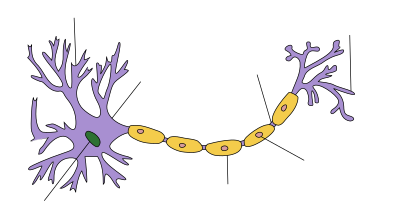Calyx of Held
| Myelin sheath |
|---|
The Calyx of Held is a particularly large synapse in the mammalian auditory central nervous system, so named by Hans Held in his 1893 article Die centrale Gehörleitung because of its resemblance to the calyx of a flower. Globular bushy cells in the anteroventral cochlear nucleus (AVCN) send axons to the contralateral medial nucleus of the trapezoid body (MNTB), where they synapse via these calyces on MNTB principal cells. These principal cells then project to the ipsilateral lateral superior olive (LSO), where they inhibit postsynaptic neurons and provide a basis for interaural level detection (ILD), required for high frequency sound localization. This synapse has been described as the largest in the brain.
The related endbulb of Held is also a large axon terminal smaller synapse (15-30 µm in diameter) found in other auditory brainstem structures, namely the cochlear nucleus. As with the calyces, these synapses promote fast, efficient information transfer.
The calyx of Held holds vesicles containing glutamate on the presynaptic terminal, the vesicles are released upon stimulation (originating in the auditory system). The glutamate then binds to two known glutamate receptors, AMPA- and NMDA receptors.
Commonly used in research due to its large size, the calyx of Held has been used to understand a variety of mechanisms related to development of, and vesicle release of the synapse.
The calyx of Held is a part of the auditory system, connecting the globular bushy cells (GBCs) of the anteroventral cochlear nucleus to the principal neurons of the medial nucleus of the trapezoid body (MNTB). As a synapse, the function of the calyx of Held is to transmit the signal from the GBCs to the principal neurons. The principal neurons of the MNTB are glycinergic, thus hyperpolarizing the superior olivary complex (SOC) nuclei in nearby cells and producing tonotopic inhibitory effects. As a result of its role in stimulating the principal neurons, the primary function of the calyx of Held is to allow differentiation between temporal activation of the cochlear hair cells that are important in sound localization (interaural level detection).
...
Wikipedia

